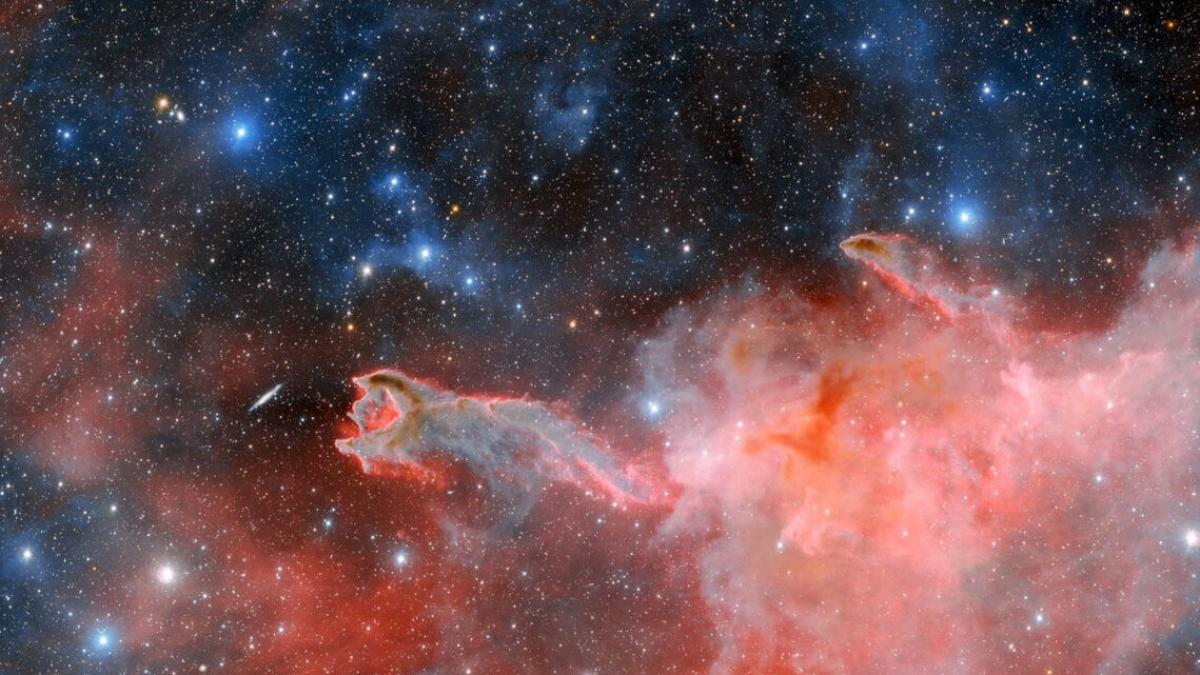About 1,300 light-years away, in the constellation Puppis, a ghostly arm emerges from the interstellar medium and reaches into space.
The image was obtained by the Dark Energy Camera at the Cerro Tololo Observatory in Chile, part of the NOIRLab project.
According to NASA, it's a compact comet cluster called CG4, nicknamed the “Hand of God,” one of several comet groups in the Milky Way. The unique shape of these objects and their formation is a topic of debate among astronomers.
Cometary globules are a subset of dark nebulae known as Boke globules, isolated clouds of dense cosmic gas and dust surrounded by extremely hot, ionized material.
When a detachment of material occurs in these clouds and a tail expands into space, they are called comet globules because of their vague resemblance to comets, although they have nothing in common.
The characteristics that characterize CG 4 as a cometary globule do not go unnoticed in this image made by the DOE and taken by the Dark Energy Camera (DECam) installed on the Víctor M. Blanco 4-meter telescope at Cerro Tololo Observatory (CTIO). , an NSF NOIRLab project. Its dusty head, 1.5 light-years in diameter, and its long, wispy tail, about eight light-years long, make CG 4 a small poke globule, a common characteristic of cometary globules.
Although these objects were first observed in 1976 from images obtained by England's Schmidt telescope in Australia, for a long time, cometary globules were not detected by astronomers because they are very faint objects. Their tails are covered in dark stardust, blocking most light from passing through.
Currently, however, DECam, with its hydrogen-alpha filter, can capture the faint red glow of ionized hydrogen in the head and outer rim of CG 4.
This light is produced when hydrogen is ignited after being hit by radiation from hot, nearby massive stars.
However, the intense radiation produced by these nearby massive stars gradually destroys the globular head, sweeping away the tiny particles that scatter the starlight.
However, CG 4's dusty cloud contains enough gas to fuel the active formation of many new solar-sized stars.
Although astronomers have observed these structures throughout the Milky Way, most of them are inside a large bubble of glowing gas called the Gum Nebula, including CG 4, which contains 31 cometary globules in addition to CG 4.
This nebula is believed to be nothing more than the expanding remnants of a supernova that occurred about a million years ago.
The mechanism by which these comet-like objects acquire their characteristic shape is not well understood, but astronomers have at least two main ideas about their origin.
First, initially, they could correspond to spherical nebulae such as the Ring Nebula, which were later affected by a nearby supernova explosion, perhaps the original explosion that created the Gum Nebula.
A second idea suggests that cometary globules are formed by a combination of stellar winds and radiation pressure from hotter, nearby massive stars.
In fact, all cometary globules found within the Gum Nebula appear to have tails extending from the center of the nebula, where the Vela supernova remnant and the Vela pulsar are located.
The latter consists of a rapidly rotating neutron star formed after the collapse of a massive star, and whose stellar wind and radiation pressure can shape nearby globules.
The image also gives the impression that CG 4 is about to swallow the edge-on spiral galaxy ESO 257-19 (PGC 21338).
But in reality, the galaxy is more than a hundred million light-years beyond CG 4 and is only close by a chance alignment.




:quality(85)/cloudfront-us-east-1.images.arcpublishing.com/infobae/TEQF6EONZRFGLLLDIDD4L2O4EE.jpg)
:quality(85)/cloudfront-us-east-1.images.arcpublishing.com/infobae/ALZ45QGJHVBDLMWI33TRDPQ2YA.png)